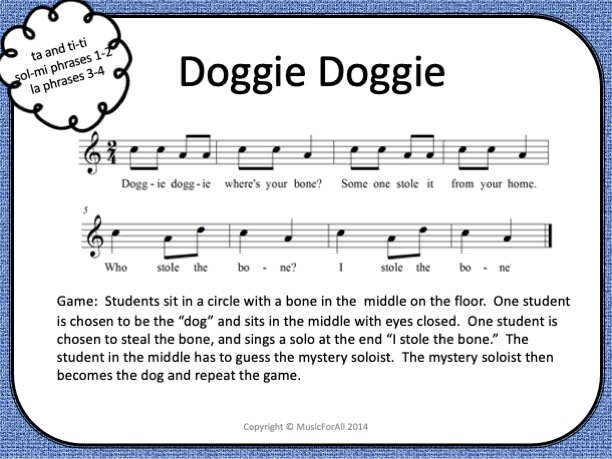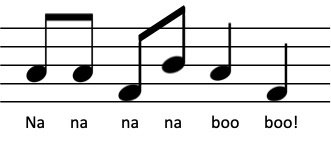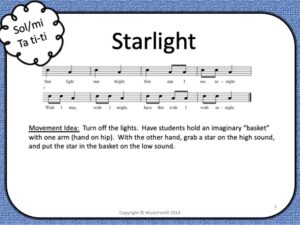Are you looking for a game with solo singing? Are you teaching elementary music and need a quick assessment? Do you need a music class name game to help learn all the new students in your class? Doggie Doggie is one of my students’ favorite games to play and a great tool to have students practice their solo singing. It’s a quick and fun way to get an assessment in your grade books or show growth with student data.

How to Play the Singing Game
The game is very simple. In my music class, students sit in a circle on the floor. You could also do this game in a classroom with desks and chairs. One child is chosen to be the “dog” and goes in the middle and closes their eyes. As the class is singing the song, pick one student, go and steal the bone and go back to their spot. At the song’s end, the “thief” sings, “I stole your bone.” Then, the child in the middle wakes up and has three guesses to name the child who sang the solo.
Materials Needed for Game
Sometimes when teaching elementary music, we might not have a lot of materials or even a music room to call our own. One nice thing about this signing game is you don’t need anything to play except a bone. I have used a real plastic dog chew bone before, but most of the time, I use an eraser. Other things that would work are a rhythm stick or a dry-erase marker. Super simple!
Assessment While Playing a Singing Game
Since I started teaching, assessment has continued to be a bigger priority in music class. One issue with assessing children is the time it takes to do it. I only have music once a week, which equals about 36 hours a year. That’s 36 hours of instruction for my entire curriculum. If you have a performance in there, it takes up a portion of your time as well.
When they are in music class, I want students to play singing games and make music as much as possible. The idea of a paper and pencil assessment doesn’t sound like the best use of my time. After all, I want students to enjoy music, learn about music, and want to make music in the future. Giving them a quiz or a test seems to suck the joy out of learning about music.
That’s where games like Doggie Doggie are so helpful. As the students are playing the game, get your roster ready. After a child sings, please give them a quick assessment of their voice. There are two ways you can do this.
Option 1 – Simple Rubric of Singing Voice
As students are playing the singing game, take a quick assessment at the same time! They think they are playing a game, but little do they know you are giving them an assessment! It is quick, easy, and does not require doing a worksheet.
1 = student sings accurate pitch. The student is in-tune.
2 = student is singing but a little out of tune
3 = student is not singing, or the child is singing with a pitch but way out of tune, such as starting too high or too low.
Option 2 – More Advanced Assessment
Label them using the Singing Voice Development Measure (Rutkowski).
First, you should determine if a child is singing or speaking. If they are speaking, label them as Speaking Voice. If they are using a singing voice, then you have to determine if they are singing accurately in tune or if they are out of tune.
Types of singing voices:
- Emerging Singer – sings in tune when singing a solo but sings out of tune with the class.
- Dependant Singer – sings in tune when the class is singing but out of tune when singing a solo.
- Transposing Pattern Singer – Starts on the wrong note but sings all of the intervals correctly.
- Speaking Voice Singer – sings in speaking voice range – Is using pitch, but is too low.
- Above the Pitch Singer – Sings too high, and intervals are inaccurate.
- Directional Singer – Goes up and down with the melody, but the intervals are not accurate.
- Out of Tune Singer – randomly sings out of tune and doesn’t fit into one of the above descriptions.
One reason students sing out of tune is lack of experience. Give them lots of experience by playing singing games.
Kodaly Method Music Literacy
This song is great for teaching quarter notes and paired eighth notes, as well as teaching sol mi and la.
I consider this song a sol mi song and a la song. When working on sol/mi, I only use the 1st and 2nd phrases. For la, you can use the 3rd phrase and the 4th phrase (solo).

An interesting element of this song is the jump from mi to la. The pattern m – l – s happens in this song and gives students a chance to practice singing the interval of perfect 4th. Of course, this pattern is actually easy for kids to sing. Think of the playground chant/singing that students exhibit throughout the world:

This is the reason that Zoltan Kodaly decided to start with sol mi and la melodies. They are easy and natural for students to sing. Because they are easy, students find success. When they are successful, they want to sing more!
Singing Games Build Sucess
Success Builds Success. We want to do a lot of these games with singing to help students learn to sing in tune. The low-pressure environment during singing games helps students relax and not get embarrassed by singing in front of their peers. They experience singing in tune with those around them, and as they get older, we introduce more complex melodies and patterns. Just like reading a book. Literacy starts with reading simple phases and gradually building our vocabulary. When we can read, the entire world is available to us.
And that’s what we want for our students’ musical literacy. For the entire musical world to be available to them.
Start with simple songs, logically sequence your instruction, and gradually over time, build music literacy.



